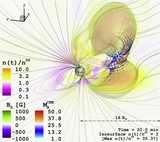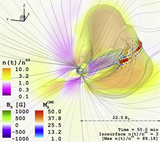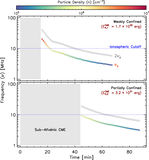Image Details

Caption: Figure 5.
Global Alfvénic regimes as a function of distance in our simulated M-dwarf CME events (left: weakly suppressed, Figure 3; right: partially suppressed, Figure 4). In circles, and color-coded by simulation time, is the radial CME speed in the stellar wind frame ﹩\left\langle {U}_{{\rm{R}}}^{\mathrm{CME}}-{V}_{{\rm{R}}}^{\mathrm{SW}}\right\rangle ﹩, spatially averaged over the expanding front. The mean Alfvén speed values ﹩\left\langle {V}_{{\rm{A}}}\right\rangle ﹩, computed over the same spatial locations, are indicated by downward triangles. The nominal transition from sub-Alfvénic, ﹩\left\langle {M}_{{\rm{A}}}^{\mathrm{CME}}\right\rangle \lt 1﹩, to super-Alfvénic, ﹩\left\langle {M}_{{\rm{A}}}^{\mathrm{CME}}\right\rangle \gt 1﹩, is indicated. The spike in speed at a distance of ∼﹩6.5\,{R}_{\unicode{x02605}}﹩ in the right panel is due to the fragmentation of the CME, where the average speed is dominated by the outermost small fragments escaping the large-scale confinement (see Alvarado-Gómez et al. 2019a, 2019b).
Copyright and Terms & Conditions
© 2020. The American Astronomical Society. All rights reserved.








